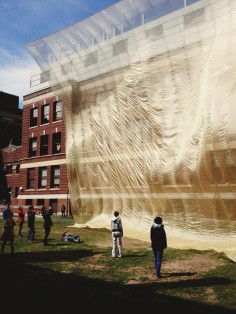LEAH MEDIN
The Gold Divide
source: highlike
Work: April 16th to April 25th, 2013 In The Courtyard at Massachusetts College of Art and Design. Gold crystal organza fabric, polyester thread, tarp lining, grommets, galvanized aircraft cable, clamps and thimbles. 57′ x 80′
Photographer: Fiona Stoltze
.
.
.
.
.
.
.
source: leahmedin
I have lived in the US for most of my life, but I have been able to travel to many different places in the world. I feel that this exposure to different environments has definitely influenced my work as an artist. I find that the people in my life and the physical spaces that I live in day to day are very important to my artwork. My work is driven by an interest in different processes and materials. Through color and composition I create shapes and patterns both in two-dimensional and three-dimensional forms. I have worked in many different processes such as weaving, sewing, pattern design, silkscreening, stamping, hand dyeing, carving wood and working with metal.
I am currently earning a BFA in Fibers at Massachusetts College of Art and Design. I lived in Amsterdam for six and a half months in the Spring of 2012 where I joined the TXT department at the Gerrit Rietveld Academie. It was an incredible experience and I hope to return to the Netherlands again one day. I anticipate to graduate in May of 2013.
.
.
.
.
.
.
.
source: blogsmassartedu
Many of us were soothed by Fibers major, Leah Medin’s piece, The Gold Divide, which was installed in the courtyard last week. In a bit of serendipitous timing, Leah was here finishing her final hand-sewing on Monday, April 15th, while the campus was quiet due to the Patriots’ Day holiday. The piece went up the next morning, as the entire community—students, faculty, and staff alike—returned to campus while still in shock and horror over the Marathon bombing.
The central location, the sheer size of the piece, the calming effect of watching the way the giant swath of fabric gracefully moved in the wind (sometimes physically “washing over” people), and its constantly changing shapes drew people to the courtyard, and started conversations. This installation provided a much-needed respite and a place to connect with others, as we all attempted to process this violent event that was so close to home. For that, we’re grateful, and thank Leah.


